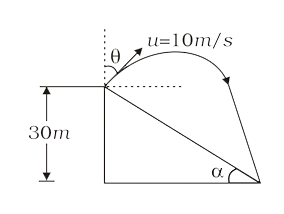A ball is thrown upwards from the ground with an initial speed of u. The ball is at height of 80m at two times, the time interval being 6 s. Find u. Take g=10m/s2.
The correct Answer is:A
To solve the problem step by step, we will use the kinematic equations of motion. The key points to note are that the ball reaches a height of 80 m at two different times, and the time interval between these two instances is 6 seconds. We will also consider the acceleration due to gravity (g) as -10 m/s² (negative because it acts downward).
1. Identify the known values:
- Height (s) = 80 m
- Time interval (Δt) = 6 s
- Acceleration due to gravity (g) = -10 m/s²
2. Use the kinematic equation:
The kinematic equation we will use is:
s=ut+12at2
where:
- s is the displacement (80 m),
- u is the initial velocity (which we need to find),
- a is the acceleration (-10 m/s²),
- t is the time.
Plugging in the values, we get:
80=ut−5t2
Rearranging gives us:
5t2−ut+80=0
3. Recognize the quadratic equation:
The equation 5t2−ut+80=0 is a quadratic equation in t. The roots of this equation will give us the two times (t1 and t2) at which the ball is at a height of 80 m.
4. Use the quadratic formula:
The roots of the quadratic equation at2+bt+c=0 can be found using:
t=−b±√b2−4ac2a
Here, a=5, b=−u, and c=80. Thus, we have:
t=u±√u2−160010
5. Set up the time difference:
The difference between the two times (t2 - t1) is given as 6 seconds:
t2−t1=u+√u2−160010−u−√u2−160010=6
Simplifying this gives:
2√u2−160010=6
Multiplying both sides by 10:
2√u2−1600=60
Dividing by 2:
√u2−1600=30
6. Square both sides:
Squaring both sides gives:
u2−1600=900
Rearranging gives:
u2=2500
7. Solve for u:
Taking the square root of both sides:
u=√2500=50 m/s
Final Answer:
The initial speed u at which the ball was thrown upwards is 50 m/s.
---
- Height (s) = 80 m
- Time interval (Δt) = 6 s
- Acceleration due to gravity (g) = -10 m/s²
The kinematic equation we will use is:
s=ut+12at2
where:
- s is the displacement (80 m),
- u is the initial velocity (which we need to find),
- a is the acceleration (-10 m/s²),
- t is the time.
80=ut−5t2
Rearranging gives us:
5t2−ut+80=0
The equation 5t2−ut+80=0 is a quadratic equation in t. The roots of this equation will give us the two times (t1 and t2) at which the ball is at a height of 80 m.
The roots of the quadratic equation at2+bt+c=0 can be found using:
t=−b±√b2−4ac2a
Here, a=5, b=−u, and c=80. Thus, we have:
t=u±√u2−160010
The difference between the two times (t2 - t1) is given as 6 seconds:
t2−t1=u+√u2−160010−u−√u2−160010=6
Simplifying this gives:
2√u2−160010=6
Multiplying both sides by 10:
2√u2−1600=60
Dividing by 2:
√u2−1600=30
Squaring both sides gives:
u2−1600=900
Rearranging gives:
u2=2500
Taking the square root of both sides:
u=√2500=50 m/s
The initial speed u at which the ball was thrown upwards is 50 m/s.
Topper's Solved these Questions
- KINEMATICSBOOK - DC PANDEY ENGLISHCHAPTER - KINEMATICSEXERCISE - Example Type 1
1 Videos
- KINEMATICSBOOK - DC PANDEY ENGLISHCHAPTER - KINEMATICSEXERCISE - Example Type 2
1 Videos
- GRAVITATIONBOOK - DC PANDEY ENGLISHCHAPTER - GRAVITATIONEXERCISE - (C) Chapter Exercises
45 Videos
- KINEMATICS 1BOOK - DC PANDEY ENGLISHCHAPTER - KINEMATICS 1EXERCISE - INTEGER_TYPE
15 Videos
Similar Questions
A ball is thrown vertically upwards from the top of tower of height h with velocity v . The ball strikes the ground after time.
View SolutionA ball thrown vertically upwards with an initial velocity of 1.4m/s. The total displcement of the ball is
View SolutionA ball is thrown upwards, it takes 4 s to reach back to the ground. Find its initial velocity
View SolutionA ball is thrown upwards with a speed u from a height h above the ground.The time taken by the ball to hit the ground is
View SolutionA ball is thrown upwards from the top of a tower 40m high with a velocity of 10m/s. Find the time when it strikes the ground. Take g=10m/s2.
View SolutionA ball is thrown upwards from the top of a tower 40m high with a velocity of 10m/s. Find the time when it strikes the ground. Take g=10m/s2.
View SolutionA particle of mass 2m is dropped from a height 80 m above the ground. At the same time another particle of mass m is thrown vertically upwards from the ground with a speed of 40 m/s. If they collide head-on completely inelastically, the time taken for the combined mass to reach the ground, in units of second is:
View SolutionA ball is thrown upward from edge of a cliff with an intial velocity of 6 m/s. How fast is it moving 1/2 s later ?(g=10ms2)
View SolutionFind the average velocity of a particle released from rest from a height of 125m over a time interval till it strikes the ground. Take g=10m/s2.
View SolutionA ball is thrown upwards from the top of an incline with angle of projection θ with the vertical as shown. Take θ=60∘ and g=10m/s2 . The ball lands exactly at the foot of the incline.

The time of flight of the ball is:
View Solution
